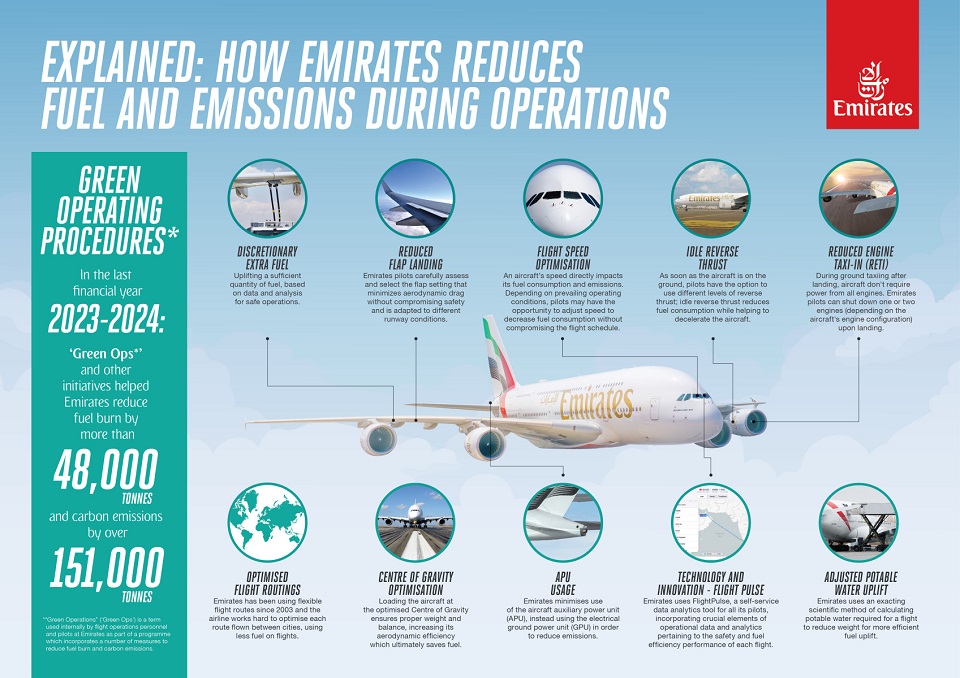Aviation
How Emirates pilots reduce fuel and emissions during operations

Flying smarter and minimizing fuel consumption and emissions starts in the cockpit. Emirates embarked on implementing “Green Operating Procedures” (‘Green Ops’) in 2016, adopting a multi-pronged approach to reduce on-ground and in-flight fuel use.
This initiative also provides pilots with necessary education, awareness, data analytics, and technology to manage flights efficiently.
Led by an internal cross-functional Operations Efficiency Steering Group, Emirates aims to mitigate unnecessary fuel burn and emissions while maintaining high safety standards.
In the financial year 2023-2024, ‘Green Ops’ and other initiatives helped reduce fuel burn by over 48,000 tonnes and carbon emissions by more than 151,000 tonnes. Key operational measures include:
Discretionary Extra Fuel
- Pilots assess operational circumstances to uplift extra fuel beyond the minimum regulatory standards only when necessary, resulting in a significant reduction of discretionary extra fuel uplift.
Flight Speed Optimization
- Pilots optimize flight speed to reduce fuel consumption while maintaining schedule integrity, as part of Emirates’ standard operating procedures.
Reduced Flap Landing
- Pilots select flap settings that minimize aerodynamic drag, reducing fuel consumption without compromising safety.
Idle Reverse Thrust
- Upon landing, pilots use idle reverse thrust to decelerate the aircraft, depending on runway conditions, to reduce fuel consumption.
Reduced Engine Taxi-In (RETI)
- After landing, pilots shut down one or two engines during ground taxiing, increasing the use of RETI sevenfold since its introduction.
Optimized Flight Routings
- Emirates uses flexible flight routes, optimizing each route for fuel efficiency and time savings since 2003.
Technology and Innovation – FlightPulse
- Emirates introduced FlightPulse, a self-service data analytics tool developed with GE Digital Aviation Services, enhancing monitoring and collaboration for improved safety and fuel efficiency.
Center of Gravity Optimization
- Aircraft are loaded to optimize the center of gravity, enhancing aerodynamic efficiency and saving fuel.
APU Usage
- On the ground, Emirates reduces APU usage in favor of electrical ground power units (GPU), reducing emissions by over 30%.
Adjusted Potable Water Uplift
- Flights upload the required amount of potable water calculated scientifically, reducing weight and ensuring fuel efficiency without compromising passenger comfort.
Through these comprehensive measures, Emirates pilots play a crucial role in reducing fuel consumption and emissions, contributing to more sustainable airline operations.

Aviation
COMAC Unveils Plans for the C929 to Rival Airbus and Boeing

After the success of China’s first C919 aircraft, the country is setting its sights on developing a larger plane. COMAC (Commercial Aircraft Corporation of China) has officially confirmed plans to build a widebody aircraft, marking a significant step in its aircraft lineup.
Traditionally, Airbus and Boeing dominate the widebody aircraft market, with decades of expertise in developing planes and engines capable of carrying heavy payloads. China, which currently relies on imported engines, is now aiming to challenge these giants with its own widebody jet, the C929, designed to compete with the Airbus A350 and Boeing 777.
American Airlines Is Looking for Flight Attendants: Apply Now
The C929 will be China’s first independently developed long-range widebody aircraft. It adheres to international airworthiness standards and boasts independent intellectual property rights. The baseline version is designed to seat 280 passengers and offers a range of 12,000 kilometers, catering to global demand for both regional and international air travel.
Russia, which also needs reliable narrowbody and widebody aircraft, could become a key customer for the C929. Additionally, China plans to target the broader Asian market as it continues to expand its aviation capabilities.
Close Call at Heathrow: BA Flight Narrowly Escapes Drone Collision
China’s aviation progress includes the ARJ21 (now called C909), a regional jet with 100 seats for shorter routes, and the C919, a narrowbody jet with 180 seats designed to rival the Boeing 737 MAX and Airbus A320. Both models have found increasing demand in the domestic market.
At China’s largest air show in Zhuhai, COMAC announced that Air China will be the launch customer for the C929 widebody jet, though details about order size and delivery timelines were not disclosed.
Other major deals announced by COMAC include:
- Hainan Airlines: Firm orders for 60 C919 and 40 C909 regional jets.
- Colorful Guizhou Airlines: 30 C909 jets, with 20 firm orders and 10 provisional agreements.
The C929, renamed from the CR929 after Russia withdrew from the joint development project in 2023, is expected to carry 280–400 passengers with a range of 12,000 kilometers, competing directly with Boeing’s 787 Dreamliner.
According to COMAC’s deputy general manager, Tong Yu, the first fuselage section of the C929 is expected by September 2027, with prototype test flights anticipated soon after.
-

 Aviation2 months ago
Aviation2 months agoMicrosoft Flight Simulator Raises $3 Million to Bring Back the An-225 Mriya
-

 Airlines2 months ago
Airlines2 months agoQantas Engineers Stage Walkout Over Cost of Living Concerns
-

 Airlines2 months ago
Airlines2 months agoQatar Citizens Can Travel to the United States Without a Visa
-

 Aviation2 months ago
Aviation2 months agoQatar Airways bans these new Electronic Devices on plane
-

 Airlines2 months ago
Airlines2 months agoJapan Airlines Rolls Out Free Domestic Flights to International Passengers
-

 Defence2 months ago
Defence2 months agoWhich Country Has the Largest Fleet of Fighter Aircraft?
-

 Airport2 months ago
Airport2 months agoWestern Sydney Airport Welcomes Its First Plane After 6 Years of construction
-

 Travel2 months ago
Travel2 months agoQatar Airways Launches Four Additional Flights from Amsterdam









